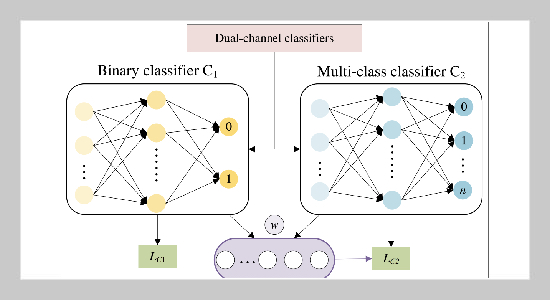- [1] H.Shang,Z.Liu,Y.Wei,andS.Zhang,(2024)“Anovel faultdiagnosismethodforapowertransformerbasedon multi-scaleapproximateentropyandoptimizedconvolu tionalnetworks"Entropy26(3):186.DOI:10.3390/e26030186.
- [2] O.Kherif,Y.Benmahamed,M.Teguar,A.Boubakeur, andS.S.Ghoneim,(2021)“Accuracyimprovementof powertransformerfaultsdiagnosticusingKNNclassi fierwithdecisiontreeprinciple"IEEEAccess9:81693 81701.DOI:10.1109/ACCESS.2021.3086135.
- [3] B.Raja,G.Venkatakrishnan,andR.Rengaraj,(2024) “Powertransformerfaultdiagnosisandconditionmonitor ingusinghybridTDO-SNNtechnique"International JournalofHydrogenEnergy68:1370–1381.DOI:10.1016/j.ijhydene.2024.03.115.
- [4] G.Wang,Y.Liu,X.Chen,Q.Yan,H. Sui,C.Ma, andJ.Zhang,(2021)“Powertransformerfaultdiagnosis systembasedonInternetofThings"EurasipJournalon WirelessCommunicationsandNetworking2021: 1–24.DOI:10.1186/s13638-020-01871-6.
- [5] M.Demirci,H.Gözde, andM.C.Taplamacioglu, (2023)“Improvementofpowertransformerfaultdiagnosis byusingsequentialKalmanfiltersensorfusion"Interna tionalJournalofElectricalPower&EnergySystems 149:109038.DOI:10.1016/j.ijepes.2023.109038.
- [6] A.Rangel Bessa, J. Farias Fardin, P. Marques Ciarelli, and L. Frizera Encarnação, (2023) “Conventional dis solved gases analysis in power transformers" Energies 16(21): 7219. DOI: 10.3390/en16217219.
- [7] A.Wajid,A.U.Rehman,S.Iqbal, M.Pushkarna, S. M. Hussain, H. Kotb, M. Alharbi, and I. Zaitsev, (2023) “Comparative performance study of dissolved gas analysis (DGA) methods for identification of faults in power trans former" International Journal of Energy Research 2023(1): 9960743. DOI: 10.1155/2023/9960743.
- [8] X.Han,S.Huang,X.Zhang,Y.Zhu,G.An,andZ.Du, (2023) “Atransformer condition recognition method based on dissolved gas analysis features selection and multiple models fusion" Engineering Applications of Artificial Intelligence 123: 106518. DOI: 10.1016/j.engappai.2023.106518.
- [9] N.A.Bakar,I. S. Chairul, S. Ab Ghani, M. S. A. Khiar, and M. Z. C. Wanik, (2023) “Improvement of trans former dissolved gas analysis interpretation using J48 decision tree model" IAES International Journal of Artificial Intelligence 12(1): 48. DOI: 10.11591/ijai.v12.i1.pp48-56.
- [10] Y. Jin, H. Wu, J. Zheng, J. Zhang, and Z. Liu, (2023) “Power transformer fault diagnosis based on improved BP neural network" Electronics 12(16): 3526. DOI: 10.3390/electronics12163526.
- [11] Z. Xing and Y. He, (2023) “Multimodal Mutual Neural Network for Health Assessment of Power Transformer" IEEE Systems Journal 17(2): 2664–2673. DOI: 10.1109/JSYST.2023.3237225.
- [12] I. B. Taha, S. Ibrahim, and D.-E. A. Mansour, (2021) “Power transformer fault diagnosis based on DGA using a convolutional neural network with noise in measure ments" IEEE Access 9: 111162–111170. DOI: 10.1109/ACCESS.2021.3102415.
- [13] W. Zeng, Y. Cao, L. Feng, J. Fan, M. Zhong, W. Mo, and Z. Tan, (2023) “Hybrid CEEMDAN-DBN-ELM for online DGA serials and transformer status forecasting" Electric Power Systems Research 217: 109176. DOI: 10.1016/j.epsr.2023.109176.
- [14] Y. Zhou, Y. Liu, N. Wang, X. Han, and J. Li, (2022) “Partial discharge ultrasonic signals pattern recognition in transformer using BSO-SVM based on microfiber coupler sensor" Measurement 201: 111737. DOI: 10.1016/j.measurement.2022.111737.
- [15] X.Yang,W.Chen,A.Li,C.Yang,Z.Xie,andH.Dong, (2019) “BA-PNN-based methods for power transformer fault diagnosis" Advanced engineering informatics 39: 178–185. DOI: 10.1016/j.aei.2019.01.001.
- [16] R. A. Prasojo, M. A. A. Putra, M. E. Apriyani, A. N. Rahmanto, S. S. Ghoneim, K. Mahmoud, M. Lehto nen, M. M. Darwish, et al., (2023) “Precise transformer fault diagnosis via random forest model enhanced by syn thetic minority over-sampling technique" Electric Power Systems Research 220: 109361. DOI: 10.1016/j.epsr.2023.109361.
- [17] F. Lv, G. Liu, Q. Wang, X. Lu, S. Lei, S. Wang, and K. Ma, (2023) “Pattern recognition of partial discharge in power transformer based on infogan and cnn" Journal of Electrical Engineering & Technology 18(2): 829–841. DOI: 10.1007/s42835-022-01260-7.
- [18] W. Liao, B. Bak-Jensen, J. R. Pillai, Y. Wang, and Y. Wang, (2021) “A review of graph neural networks and their applications in power systems" Journal of Modern Power Systems and Clean Energy 10(2): 345–360. DOI: 10.35833/MPCE.2021.000058.
- [19] M.S. Ali, A. Omar, A. S. A. Jaafar, S. H. Mohamed, et al., (2023) “Conventional methods of dissolved gas analysis using oil-immersed power transformer for fault diagnosis: A review" Electric Power Systems Research 216: 109064. DOI: 10.1016/j.epsr.2022.109064.
- [20] W.Liao, D. Yang, Y. Wang, and X. Ren, (2020) “Fault diagnosis of power transformers using graph convolu tional network" CSEE Journal of Power and Energy Systems 7(2): 241–249. DOI: 10.17775/CSEEJPES.2020.04120.
- [21] T. Li, Z. Zhao, C. Sun, R. Yan, and X. Chen, (2020) “Multireceptive field graph convolutional networks for ma chine fault diagnosis" IEEE Transactions on Industrial Electronics 68(12): 12739–12749. DOI: 10.1109/TIE.2020.3040669.
- [22] A. Nanfak, S. Eke, F. Meghnefi, I. Fofana, G. M. Ngaleu, and C. H. Kom, (2023) “Hybrid DGA method for power transformer faults diagnosis based on evolution ary k-means clustering and dissolved gas subsets analysis" IEEE Transactions on Dielectrics and Electrical In sulation 30(5): 2421–2428. DOI: 10.1109/TDEI.2023.3275119.
- [23] I. B. Taha, A. Hoballah, and S. S. Ghoneim, (2020) “Optimal ratio limits of rogers’ four-ratios and IEC 60599 code methods using particle swarm optimization fuzzy logic approach" IEEE Transactions on Dielectrics and Electrical Insulation 27(1): 222–230. DOI: 10.1109/TDEI.2019.008395.
- [24] S. A. Ward, A. El-Faraskoury, M. Badawi, S. A. Ibrahim, K. Mahmoud, M. Lehtonen, and M. M. Dar wish, (2021) “Towards precise interpretation of oil trans formers via novel combined techniques based on DGA and partial discharge sensors" Sensors 21(6): 2223. DOI: 10.3390/s21062223.
- [25] S. Misbahulmunir, V. K. Ramachandaramurthy, and Y. H.M.Thayoob,(2020)“Improvedself-organizing map clustering of power transformer dissolved gas analysis using inputs pre-processing" IEEE Access 8: 71798 71811. DOI: 10.1109/ACCESS.2020.2986726.
- [26] I. B. Taha, D.-E. A. Mansour, S. S. Ghoneim, and N. I. Elkalashy, (2017) “Conditional probability-based inter pretation of dissolved gas analysis for transformer incipi ent faults" IET Generation, Transmission&Distribu tion 11(4): 943–951. DOI: 10.1049/iet-gtd.2016.0886.
















